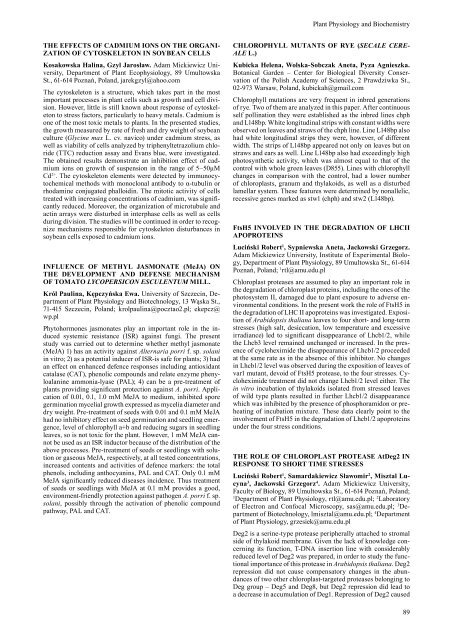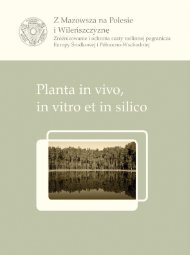acta societatis botanicorum poloniae - LV Zjazd Polskiego ...
acta societatis botanicorum poloniae - LV Zjazd Polskiego ...
acta societatis botanicorum poloniae - LV Zjazd Polskiego ...
Create successful ePaper yourself
Turn your PDF publications into a flip-book with our unique Google optimized e-Paper software.
THE EFFECTS OF CAdMIUM IONS ON THE OrGANI-<br />
ZATION OF CYTOSKELETON IN SOYBEAN CELLS<br />
Kosakowska Halina, Gzyl Jarosław. Adam Mickiewicz University,<br />
Department of Plant Ecophysiology, 89 Umultowska<br />
St., 61-614 Poznań, Poland, jarekgzyl@ahoo.com<br />
The cytoskeleton is a structure, which takes part in the most<br />
important processes in plant cells such as growth and cell division.<br />
However, little is still known about response of cytoskeleton<br />
to stress factors, particularly to heavy metals. Cadmium is<br />
one of the most toxic metals to plants. In the presented studies,<br />
the growth measured by rate of fresh and dry weight of soybean<br />
culture (Glycine max L. cv. navico) under cadmium stress, as<br />
well as viability of cells analyzed by triphenyltetrazolium chloride<br />
(TTC) reduction assay and Evans blue, were investigated.<br />
The obtained results demonstrate an inhibition effect of cadmium<br />
ions on growth of suspension in the range of 5– 50μM<br />
Cd 2+ . The cytoskeleton elements were detected by immunocytochemical<br />
methods with monoclonal antibody to α-tubulin or<br />
rhodamine conjugated phalloidin. The mitotic activity of cells<br />
treated with increasing concentrations of cadmium, was significantly<br />
reduced. Moreover, the organization of microtubule and<br />
actin arrays were disturbed in interphase cells as well as cells<br />
during division. The studies will be continued in order to recognize<br />
mechanisms responsible for cytoskeleton disturbances in<br />
soybean cells exposed to cadmium ions.<br />
INFLUENCE OF METHYL JASMONATE (MeJA) ON<br />
THE dEVELOPMENT ANd dEFENSE MECHANISM<br />
OF TOMATO lycoPersicon esculentum MILL.<br />
Król Paulina, Kępczyńska Ewa. University of Szczecin, Department<br />
of Plant Physiology and Biotechnology, 13 Wąska St.,<br />
71-415 Szczecin, Poland; krolpaulina@pocztao2.pl; ekepcz@<br />
wp.pl<br />
Phytohormones jasmonates play an important role in the induced<br />
systemic resistance (ISR) against fungi. The present<br />
study was carried out to determine whether methyl jasmonate<br />
(MeJA) 1) has an activity against Alternaria porri f. sp. solani<br />
in vitro; 2) as a potential inducer of ISR-is safe for plants; 3) had<br />
an effect on enhanced defence responses including antioxidant<br />
catalase (CAT), phenolic compounds and relate enzyme phenyloalanine<br />
ammonia-lyase (PAL); 4) can be a pre-treatment of<br />
plants providing significant protection against A. porri. Application<br />
of 0.01, 0.1, 1.0 mM MeJA to medium, inhibited spore<br />
germination mycelial growth expressed as mycelia diameter and<br />
dry weight. Pre-treatment of seeds with 0.01 and 0.1 mM MeJA<br />
had no inhibitory effect on seed germination and seedling emergence,<br />
level of chlorophyll a+b and reducing sugars in seedling<br />
leaves, so is not toxic for the plant. However, 1 mM MeJA cannot<br />
be used as an ISR inductor because of the distribution of the<br />
above processes. Pre-treatment of seeds or seedlings with solution<br />
or gaseous MeJA, respectively, at all tested concentrations,<br />
increased contents and activities of defence markers: the total<br />
phenols, including anthocyanins, PAL and CAT. Only 0.1 mM<br />
MeJA significantly reduced diseases incidence. Thus treatment<br />
of seeds or seedlings with MeJA at 0.1 mM provides a good,<br />
environment-friendly protection against pathogen A. porri f. sp.<br />
solani, possibly through the activation of phenolic compound<br />
pathway, PAL and CAT.<br />
Plant Physiology and Biochemistry<br />
CHLOrOPHYLL MUTANTS OF rYE (secAle cere-<br />
Ale L.)<br />
Kubicka Helena, Wolska-Sobczak Aneta, Pyza Agnieszka.<br />
Botanical Garden – Center for Biological Diversity Conservation<br />
of the Polish Academy of Sciences, 2 Prawdziwka St.,<br />
02-973 Warsaw, Poland, kubickah@gmail.com<br />
Chlorophyll mutations are very frequent in inbred generations<br />
of rye. Two of them are analyzed in this paper. After continuous<br />
self pollination they were established as the inbred lines chph<br />
and L148bp. White longitudinal strips with constant widths were<br />
observed on leaves and straws of the chph line. Line L148bp also<br />
had white longitudinal strips they were, however, of different<br />
width. The strips of L148bp appeared not only on leaves but on<br />
straws and ears as well. Line L148bp also had exceedingly high<br />
photosynthetic activity, which was almost equal to that of the<br />
control with whole green leaves (D855). Lines with chlorophyll<br />
changes in comparison with the control, had a lower number<br />
of chloroplasts, granum and thylakoids, as well as a disturbed<br />
lamellar system. These features were determined by nonallelic,<br />
recessive genes marked as stw1 (chph) and stw2 (L148bp).<br />
FtsH5 INVO<strong>LV</strong>Ed IN THE dEGrAdATION OF LHCII<br />
APOPrOTEINS<br />
Luciński Robert 1 , Sypniewska Aneta, Jackowski Grzegorz.<br />
Adam Mickiewicz University, Institute of Experimental Biology,<br />
Department of Plant Physiology, 89 Umultowska St., 61-614<br />
Poznań, Poland; 1 rtl@amu.edu.pl<br />
Chloroplast proteases are assumed to play an important role in<br />
the degradation of chloroplast proteins, including the ones of the<br />
photosystem II, damaged due to plant exposure to adverse environmental<br />
conditions. In the present work the role of FtsH5 in<br />
the degradation of LHC II apoproteins was investigated. Exposition<br />
of Arabidopsis thaliana leaves to four short- and long-term<br />
stresses (high salt, desiccation, low temperature and excessive<br />
irradiance) led to significant disappearance of Lhcb1/2, while<br />
the Lhcb3 level remained unchanged or increased. In the presence<br />
of cycloheximide the disappearance of Lhcb1/2 proceeded<br />
at the same rate as in the absence of this inhibitor. No changes<br />
in Lhcb1/2 level was observed during the exposition of leaves of<br />
var1 mutant, devoid of FtsH5 protease, to the four stresses. Cycloheximide<br />
treatment did not change Lhcb1/2 level either. The<br />
in vitro incubation of thylakoids isolated from stressed leaves<br />
of wild type plants resulted in further Lhcb1/2 disappearance<br />
which was inhibited by the presence of phosphoramidon or preheating<br />
of incubation mixture. These data clearly point to the<br />
involvement of FtsH5 in the degradation of Lhcb1/2 apoproteins<br />
under the four stress conditions.<br />
THE rOLE OF CHLOrOPLAST PrOTEASE Atdeg2 IN<br />
rESPONSE TO SHOrT TIME STrESSES<br />
Luciński Robert 1 , Samardakiewicz Sławomir 2 , Misztal Lucyna<br />
3 , Jackowski Grzegorz 4 . Adam Mickiewicz University,<br />
Faculty of Biology, 89 Umultowska St., 61-614 Poznań, Poland;<br />
1 Department of Plant Physiology, rtl@amu.edu.pl; 2 Laboratory<br />
of Electron and Confocal Microscopy, sas@amu.edu.pl; 3 Department<br />
of Biotechnology, lmisztal@amu.edu.pl; 4 Department<br />
of Plant Physiology, grzesiek@amu.edu.pl<br />
Deg2 is a serine-type protease peripherally attached to stromal<br />
side of thylakoid membrane. Given the lack of knowledge concerning<br />
its function, T-DNA insertion line with considerably<br />
reduced level of Deg2 was prepared, in order to study the functional<br />
importance of this protease in Arabidopsis thaliana. Deg2<br />
repression did not cause compensatory changes in the abundances<br />
of two other chloroplast-targeted proteases belonging to<br />
Deg group – Deg5 and Deg8, but Deg2 repression did lead to<br />
a decrease in accumulation of Deg1. Repression of Deg2 caused<br />
89



